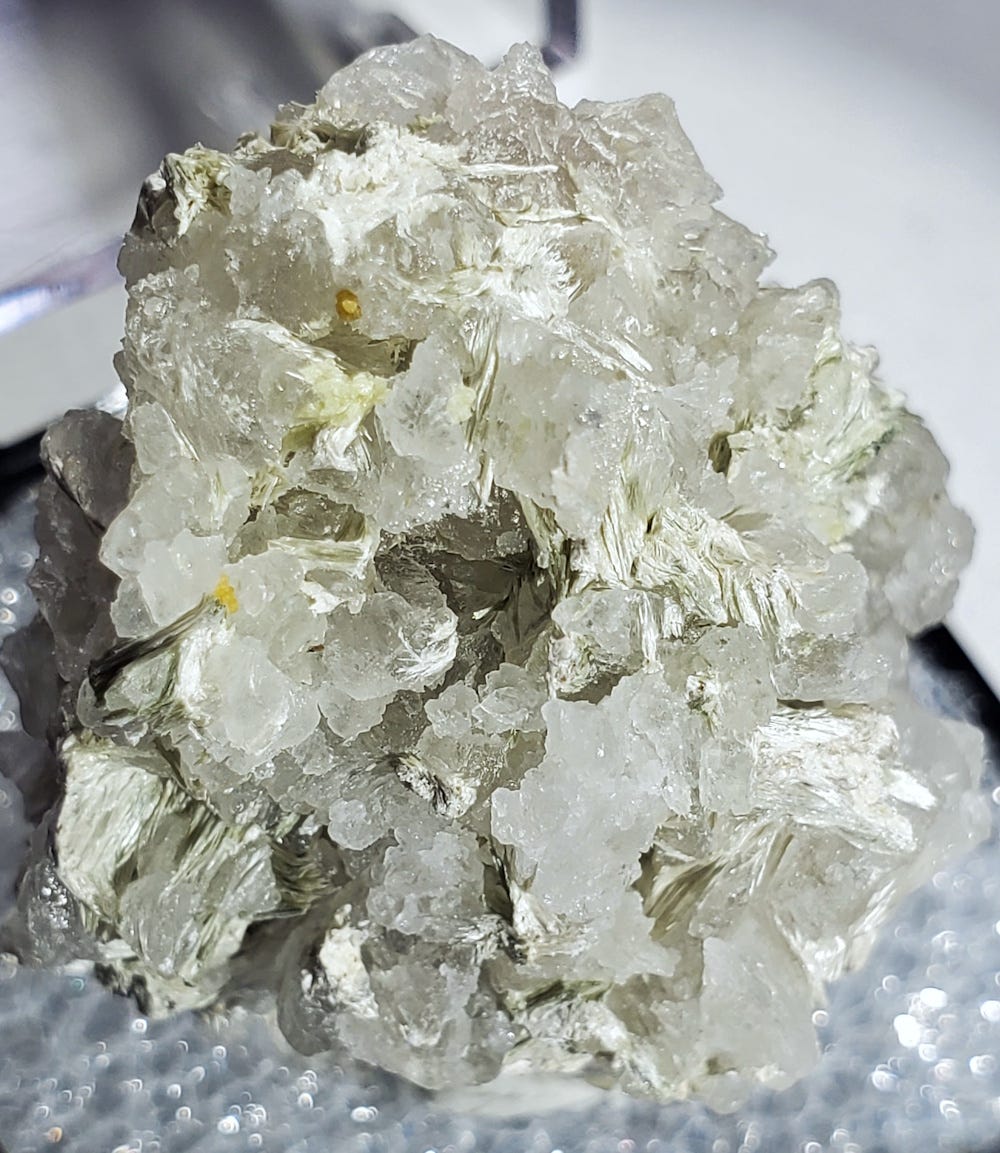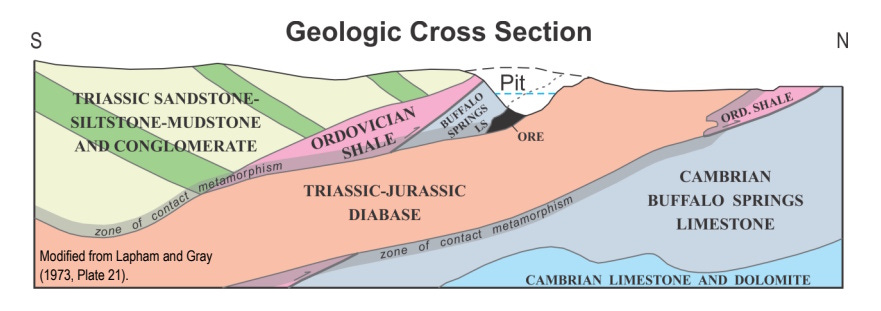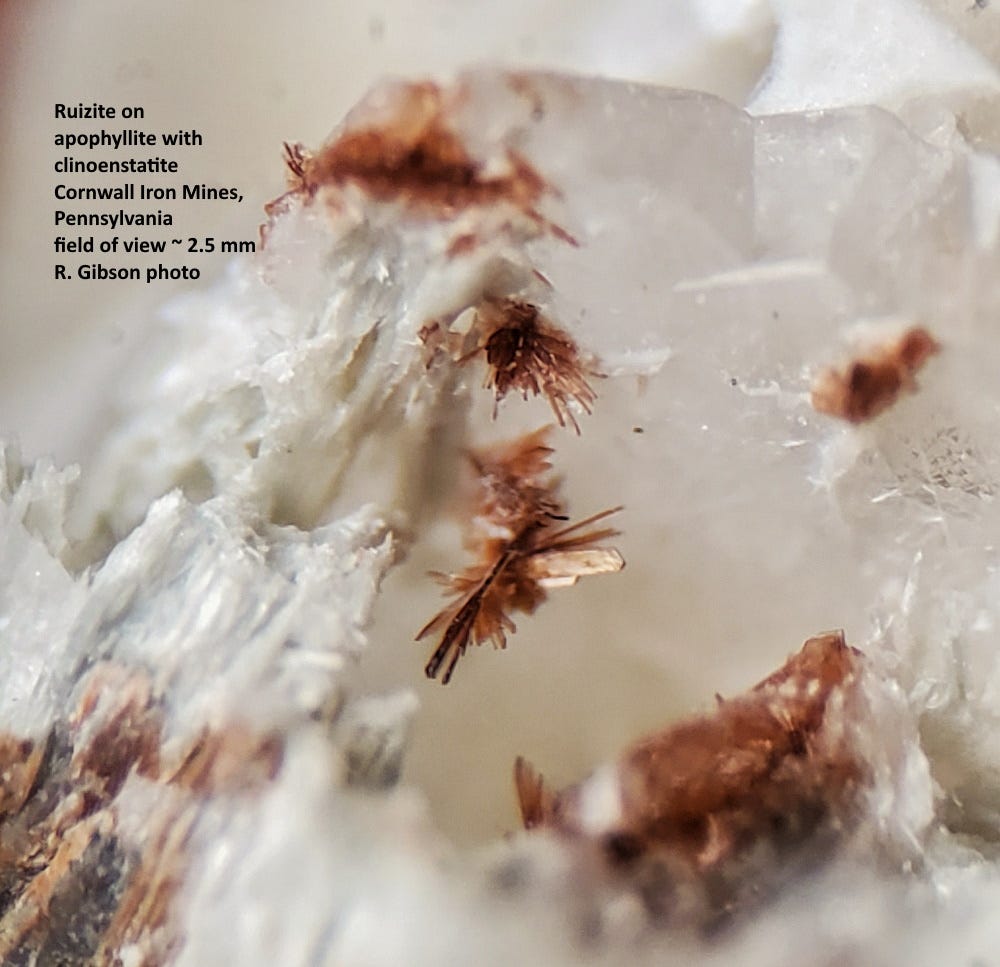Life in the USA is not normal. It feels pointless and trivial to be talking about small looks at the fascinating natural world when the country is being dismantled. But these posts will continue, as a statement of resistance. I hope you continue to enjoy and learn from them. Stand Up For Science!
Episode # 229. Ruizite is a calcium manganese silicate, Ca2Mn2[Si4O11(OH)2](OH)2 · 2H2O, first described in 1977 (Williams and Duggan, 1977, Ruizite, a new silicate mineral from Christmas, Arizona: Mineralogical Magazine, 41 (320) 429-432). It remains quite rare in the world, with only five reported occurrences: the type locality at the Christmas Mine, Arizona; Cerchiara Mine, Italy; Cavnic, Romania; Cornwall Mines, Pennsylvania; and three nearby mines in South Africa (N’Chwaning I and II and Wessels).
My specimens are from the 2007 find at the Cornwall Mines, Pennsylvania, where ruizite was found in a single 800-pound (363-kg) boulder by James “Skip” Colflesh and Bob Buckmoyer (Kearns & Kearns, 2008, Ruizite, Ca2Mn23+Si4O11(OH)·2H2O from the Cornwall Iron Mine, Lebanon Co., Pennsylvania: Mineral News, Vol. 24, No. 1).
Calcium and manganese are common enough elements, but special conditions must have existed for ruizite, such a rare mineral, to form. The Italian, Romanian, and South African occurrences are all notable manganese deposits, with the Kalahari Manganese Field in South Africa the largest deposit of manganese on land in the world. The Cavnic, Romania, deposit is also famous for manganese-bearing calcite, and it is the type locality for rhodochrosite, manganese carbonate.
Neither of the two North American occurrences is noted for manganese minerals. Both are skarns, but at both localities ruizite is the only certain manganese mineral reported present, apart from thulite (Mn-bearing zoisite) at the Christmas Mine.

At Cornwall, Pennsylvania, the rock in which the ruizite was found is mostly apophyllite, perhaps fluorapophyllite-(K), KCa4(Si8O20)(OH,F)·8H2O, and clinoenstatite, MgSiO3. In my photo the colorless, white, and gray vitreous material is the apophyllite and the fibrous white to slightly bluish material is the clinoenstatite.

The Cornwall Iron Mines in Lebanon County, Pennsylvania east of Harrisburg have a long history, dating to 1732. Iron and copper were important products along with some gold and silver, and Cornwall was the largest iron mine in the United States through much of the 1800s. Most underground mining ceased in 1972 after significant flooding from Hurricane Agnes.
The deposit gives its name to Cornwall-type iron deposits, which are laterally extensive magnetite bodies formed along the contact between intrusive igneous rocks (diabase) and carbonates (Eugster and Chou, 1979, A model for the deposition of Cornwall-type magnetite deposits: Economic Geology, 74:4, p. 763-774). The magnetite replaces carbonates in these kinds of deposits, probably derived from hot waters associated with the igneous diabase. The diabase in turn was a consequence of the fracturing of eastern North America. This represents either the early (failed) rifting in the Triassic, about 225 million years ago, or later extension as Africa and Europe pulled away at the start of the opening of the Atlantic Ocean in early Jurassic time, about 190 million years ago.

Ruizite was named for Joe Ana Ruiz (1924-2017), pharmacist, Justice of the Peace, mineralogist and mineral collector at Mammoth, Arizona.






Nice coverage of a rare mineral. I have several chunks of that boulder from Pa, nice ruizites in them, gifts from Don Peck.
Thanks for that geological column.